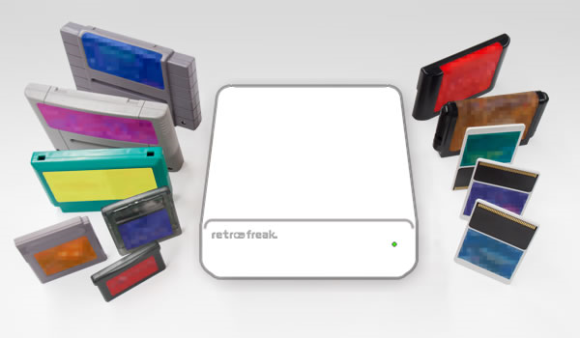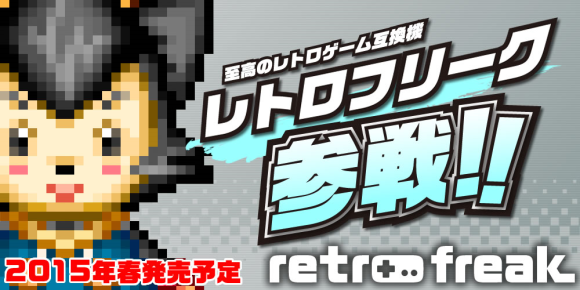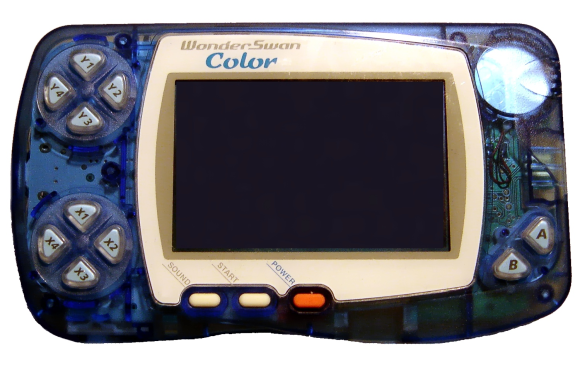
It’s a great time to be a retro gamer. The video game industry has reached a level of maturity that means there’re now decades worth of polished, legitimately enjoyable titles out there, often selling for just a fraction of the prices they commanded when new.
However, there’s one big hassle with working through an almost 30-year backlog of great games, and that’s having to hook up the half-dozen or so pieces of hardware that library is spread across. One Japanese company is proposing a solution, though, with a single console that’ll play just about any cartridge made in the 16-bit era.
CYBER Gadget Corporation, the company behind the recently announced retro freak, is a little fuzzy on the standard rules of capitalization. That’s OK, though, because the company’s real forte seems to be classic Japanese video gaming hardware.
▼ Do the understated all-lowercase “retro freak “ and the double exclamation points cancel each other out?
Most of CYBER Gadget’s other offerings are hardware peripherals, such as protective films and carrying cases for handheld systems. The retro freak, though, is a video game system itself. Actually, it’s 11 different systems in one, according to CYBER Gadget, although the company is being a little lenient in its counting methodology.
In any case, let’s run through the lengthy list of cartridge types that can be played on the retro freak:
1. Famicom
2. Super Famicom
3. Super Nintendo Entertainment System
4. Game Boy
5. Game Boy Color
6. Game Boy Advance
7. Mega Drive
8. Genesis
9. PC Engine
10. TurboGrafx-16
11. PC Engine SuperGrafx
Quite a list, huh? If we’re being picky, though, there’s a bit of overlap between the 11 entries. The Super Famicom is simply the name used in Japan for what North America and Europe called the Super NES, so systems 2 and 3 are technically the same. Super Famicom games could even be played on Super NES systems, although gamers first had to grab a pair of pliers and snap off two plastic prongs designed to physically block Super Famicom cartridges from reaching the Super NES’ connector pins.
Likewise, the Genesis is simply the North American name for Sega’s Mega Drive, and Japan’s PC Engine is the system that was rebranded as the TurboGrafx-16 elsewhere in the world. Playing one reigon’s games on a different region’s console wasn’t as easy as with the Super Famicom/Super NES, though, generally requiring a converter.
While some Game Boy Color cartridges were playable, in a downgraded mode, on the original Game Boy hardware, not all were, and the Game Boy Advance was a completely different system, just as the PC Engine SuperGrafx was a separate (and extremely short-lived) beast from the PC Engine TurboGrafx-16.
Creative calculations aside, the retro freak should let you play just about every cartridge released for a Japanese system from the launch of the Famicom in 1983 up until just before the Nintendo 64 hit the market in 1996. CYBER Gadget even claims you’ll be able to plug in a Mark III Mega Adaptor to play Sega Master System games through the Mega Drive’s semi-backwards compatibility. Just about all that’s missing, really, is the ability to play Game Gear, Neo Geo, and Wonder Swan titles.
▼ I hate to be the one to break it to you, but if you’re still carrying a torch for Bandai’s long-forgotten handheld, video gaming has passed you by.
Aside from the convenience of playing so many different libraries on one piece of hardware, CYBER gadget points out that the retro freak can be connected to your TV with an HDMI cable and will automatically upscale your classics to 720p resolution.
▼ It’s like getting new glasses (or sobering up after a night of heavy drinking).
It should be pointed out, though, that the retro freak is not officially licensed by any of the companies responsible for the consoles it’s subbing for, and CYBER gadget says there’s a possibility that certain games may not run 100-percent correctly. Pricing for the retro freak has yet to be announced, but CYBER gadget is shooting for a launch date in spring of this year.
Related: retro freak website
Source: Hachima Kiko
Top image: retro freak website
Insert images: retro freak website, Wikipedia/Michael Schmalenstroer/JD




 “Coincidentally” named video game handhelds allow you to play 8, 16-bit Nintendo games on the go
“Coincidentally” named video game handhelds allow you to play 8, 16-bit Nintendo games on the go Create 8-bit melodies by turning your old Nintendo cartridges into harmonicas 【Video】
Create 8-bit melodies by turning your old Nintendo cartridges into harmonicas 【Video】 Man in Japan arrested for selling modified Super NES Classics with extra games, making 540 bucks
Man in Japan arrested for selling modified Super NES Classics with extra games, making 540 bucks Retro game group in Japan donating 100 Super NES systems to families with kids sheltering in place
Retro game group in Japan donating 100 Super NES systems to families with kids sheltering in place Classic 16-bit Nintendo controllers get modern makeover for use with Switch, current-gen consoles
Classic 16-bit Nintendo controllers get modern makeover for use with Switch, current-gen consoles Japan’s new difficult-to-drink-from beer glass protects your liver, but it’s a brutal experience
Japan’s new difficult-to-drink-from beer glass protects your liver, but it’s a brutal experience Demon Slayer: Kimetsu no Yaiba gets new roller coaster attractions and food at Universal Studios Japan
Demon Slayer: Kimetsu no Yaiba gets new roller coaster attractions and food at Universal Studios Japan Come play hide-and-seek on a deserted Japanese island this August and November
Come play hide-and-seek on a deserted Japanese island this August and November New Pokémon ice cream, dessert drinks, and cool merch coming to Baskin-Robbins Japan【Pics】
New Pokémon ice cream, dessert drinks, and cool merch coming to Baskin-Robbins Japan【Pics】 Infographic shows how working culture differs across the globe
Infographic shows how working culture differs across the globe New Nintendo Lego kit is a beautiful piece of moving pixel art of Mario and Yoshi【Photos】
New Nintendo Lego kit is a beautiful piece of moving pixel art of Mario and Yoshi【Photos】 Real Buddhist monk plays Super Mario Bros., recites prayers every time he kills an enemy【Video】
Real Buddhist monk plays Super Mario Bros., recites prayers every time he kills an enemy【Video】 We check out the local flavors of the commonly confused Ome and Aomi areas of Tokyo in one day
We check out the local flavors of the commonly confused Ome and Aomi areas of Tokyo in one day Restaurant Yoshibei is crazy in the best way: A pork cutlet set with a side of pork cutlet bowl
Restaurant Yoshibei is crazy in the best way: A pork cutlet set with a side of pork cutlet bowl W.T.F. Japan: Top 5 craziest Japanese certification exams 【Weird Top Five】
W.T.F. Japan: Top 5 craziest Japanese certification exams 【Weird Top Five】 Nintendo history you can feel – Super NES, N64, and GameCube controllers become capsule toys
Nintendo history you can feel – Super NES, N64, and GameCube controllers become capsule toys Hello, cosmetics! Clinique teams up with Hello Kitty this summer for first-time collaboration
Hello, cosmetics! Clinique teams up with Hello Kitty this summer for first-time collaboration “The most Delicious Cup Noodle in history” – Japan’s French Cup Noodle wins our heart【Taste test】
“The most Delicious Cup Noodle in history” – Japan’s French Cup Noodle wins our heart【Taste test】 Starbucks releases a cute Frappuccino and Unicorn Cake…but not in Japan
Starbucks releases a cute Frappuccino and Unicorn Cake…but not in Japan Kyoto Tower mascot termination reveals dark side behind cute Japanese characters
Kyoto Tower mascot termination reveals dark side behind cute Japanese characters McDonald’s Japan’s Soft Twist Tower: A phantom ice cream only sold at select branches
McDonald’s Japan’s Soft Twist Tower: A phantom ice cream only sold at select branches Yabai Ramen: What makes this Japanese ramen so dangerous?
Yabai Ramen: What makes this Japanese ramen so dangerous? Finally! Nintendo Japan expands Switch 8-bit controller sales to everybody, Online member or not
Finally! Nintendo Japan expands Switch 8-bit controller sales to everybody, Online member or not Japanese government wants to build luxury resorts in all national parks for foreign tourists
Japanese government wants to build luxury resorts in all national parks for foreign tourists To combat declining birth rate, Japan to begin offering “Breeding Visas” to foreigners
To combat declining birth rate, Japan to begin offering “Breeding Visas” to foreigners 10 things you should buy at 7-Eleven in Japan
10 things you should buy at 7-Eleven in Japan Studio Ghibli releases anime heroine cosplay dresses that are super comfy to wear
Studio Ghibli releases anime heroine cosplay dresses that are super comfy to wear Woman charged for driving suitcase without a license in Osaka
Woman charged for driving suitcase without a license in Osaka Studio Ghibli unveils My Neighbour Totoro miniature house model
Studio Ghibli unveils My Neighbour Totoro miniature house model Kyoto experiencing problems with foreign tourists not paying for bus fares, but not on purpose
Kyoto experiencing problems with foreign tourists not paying for bus fares, but not on purpose Fighting mild hunger with a Japanese soda that turns into jelly in the stomach【Taste test】
Fighting mild hunger with a Japanese soda that turns into jelly in the stomach【Taste test】 Studio Ghibli’s Howl’s Moving Castle tapestry unveiled in Japan for first time
Studio Ghibli’s Howl’s Moving Castle tapestry unveiled in Japan for first time McDonald’s new Happy Meals offer up cute and practical Sanrio lifestyle goods
McDonald’s new Happy Meals offer up cute and practical Sanrio lifestyle goods Sales of Japan’s most convenient train ticket/shopping payment cards suspended indefinitely
Sales of Japan’s most convenient train ticket/shopping payment cards suspended indefinitely Sold-out Studio Ghibli desktop humidifiers are back so Totoro can help you through the dry season
Sold-out Studio Ghibli desktop humidifiers are back so Totoro can help you through the dry season Japanese government to make first change to romanization spelling rules since the 1950s
Japanese government to make first change to romanization spelling rules since the 1950s Foreigner’s request for help in Tokyo makes us sad for the state of society
Foreigner’s request for help in Tokyo makes us sad for the state of society Ghibli founders Toshio Suzuki and Hayao Miyazaki contribute to Japanese whisky Totoro label design
Ghibli founders Toshio Suzuki and Hayao Miyazaki contribute to Japanese whisky Totoro label design Doraemon found buried at sea as scene from 1993 anime becomes real life【Photos】
Doraemon found buried at sea as scene from 1993 anime becomes real life【Photos】 Tokyo’s most famous Starbucks is closed
Tokyo’s most famous Starbucks is closed Princesses, fruits, and blacksmiths: Study reveals the 30 most unusual family names in Japan
Princesses, fruits, and blacksmiths: Study reveals the 30 most unusual family names in Japan Web-based emulator adds cool retro quasi-3D effect to classic NES games 【Video】
Web-based emulator adds cool retro quasi-3D effect to classic NES games 【Video】 Game carts that plug into your phone – We took a peek at Pico Cassette at Tokyo Game Show
Game carts that plug into your phone – We took a peek at Pico Cassette at Tokyo Game Show What wonders do a Super Potato Lucky Bag hold? Grab your retro gaming hat and let’s find out!
What wonders do a Super Potato Lucky Bag hold? Grab your retro gaming hat and let’s find out! Adorable cat paw analog stick and button covers let you upgrade your PS4 to PSCat
Adorable cat paw analog stick and button covers let you upgrade your PS4 to PSCat Nintendo’s god-tier customer service continues as they offer free repairs for Noto earthquake victims
Nintendo’s god-tier customer service continues as they offer free repairs for Noto earthquake victims Take your co-op gaming to the next level with this giant Famicom controller
Take your co-op gaming to the next level with this giant Famicom controller New Super NES controller battery pack brings some retro street cred to your mobile charging needs
New Super NES controller battery pack brings some retro street cred to your mobile charging needs Nintendo eShop closing for 3DS, Wii U next year — Here’s something you might want to do right now
Nintendo eShop closing for 3DS, Wii U next year — Here’s something you might want to do right now Nintendo announces awesome mini NES loaded with 30 games that attaches directly to your TV
Nintendo announces awesome mini NES loaded with 30 games that attaches directly to your TV Think you’re a “super player”? Test your gaming habits against this Nintendo relic from the 80s
Think you’re a “super player”? Test your gaming habits against this Nintendo relic from the 80s Still got Club Nintendo points? New Zelda and Mario shirts, pouches, and more available in Japan
Still got Club Nintendo points? New Zelda and Mario shirts, pouches, and more available in Japan Luxembourg-based hobbyist’s video game dioramas are epic, wonderfully nerdy, and not for sale
Luxembourg-based hobbyist’s video game dioramas are epic, wonderfully nerdy, and not for sale Pico Cassette looks to keep cartridge games alive in a smartphone world
Pico Cassette looks to keep cartridge games alive in a smartphone world Japanese gamer builds his own custom arcade cabinet full of nostalgic feels 【Video】
Japanese gamer builds his own custom arcade cabinet full of nostalgic feels 【Video】 Ugoita fashions musical umbrellas and game cartridges for your low-fi pleasure
Ugoita fashions musical umbrellas and game cartridges for your low-fi pleasure The reason why Nintendo’s Super Mario smartphone game won’t have in-app purchases is brilliant
The reason why Nintendo’s Super Mario smartphone game won’t have in-app purchases is brilliant
Leave a Reply